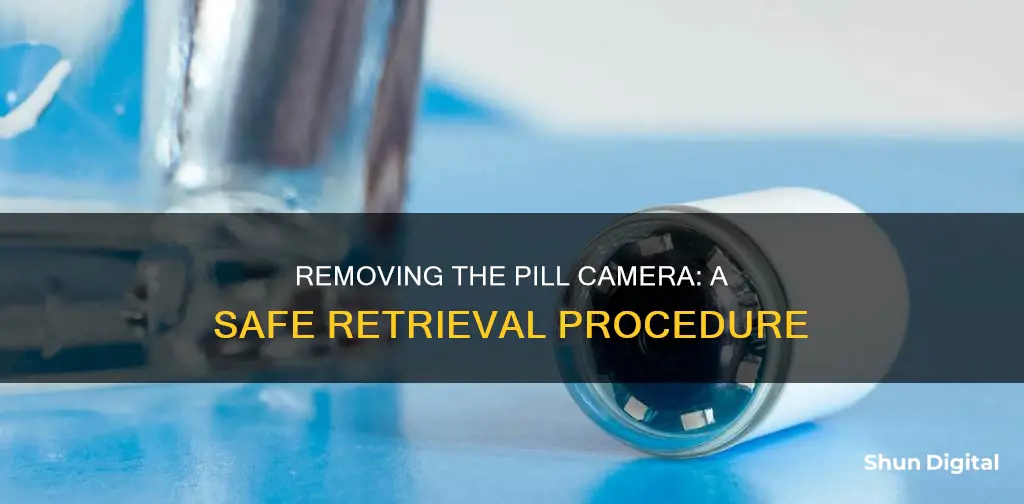
Capsule endoscopy is a procedure where a patient swallows a small pill-sized capsule that contains a disposable camera. The camera captures images of the inside of the patient's bowel, which are then transmitted to a data recorder worn by the patient. The capsule is eventually passed out of the body through a bowel movement. In rare cases, the capsule may need to be surgically removed if it becomes stuck in the patient's digestive tract. This procedure is often used to examine the small bowel and diagnose conditions such as Crohn's disease or celiac disease.
| Characteristics | Values |
|---|---|
| How is the pill camera removed? | The pill camera is removed naturally through a bowel movement. |
| How long does it take to be removed? | The pill camera is expelled in the stool in anywhere from 12 to 48 hours. |
| What if the pill camera doesn't pass naturally? | If the pill camera doesn't pass within 3 days, it may need to be removed through surgery or endoscopy. |
| What is the success rate of pill camera removal surgery? | The success rate of pill camera removal surgery is high, with successful retrieval reported in multiple cases. |
What You'll Learn

Capsule endoscopy is used to examine the small bowel
Capsule endoscopy is a non-invasive diagnostic procedure used to examine the small bowel. It is a safe, simple, and non-invasive way to visualise the inside of the small intestine, which is part of the digestive system. The procedure involves a patient swallowing a capsule containing a tiny camera, a transmitter, and a light. The capsule is about the size of a large pill, measuring just over 1 inch long and less than half an inch wide. It is easy to swallow, as it is coated to make it smooth.
Once swallowed, the capsule travels through the patient's digestive system, capturing thousands of images as it passes through the stomach, intestines, colon, and rectum. It takes about eight hours to pass through the body and can take more than 50,000 images. The images are transmitted in real time to a data recorder worn by the patient on their waist. The recorder is about the size of a large calculator and is worn on a sling or harness across the chest and shoulder. The procedure is well-tolerated, and patients do not feel the capsule as it moves through their digestive tract.
After the capsule has been swallowed, patients can go home and resume most of their daily activities. However, they should avoid strenuous exercise, sudden movements, and activities that involve sweating or bending. Patients should also stay away from MRI machines, ham radios, and strong magnetic fields until the capsule has left their body. The capsule will eventually pass through a normal bowel movement and can be flushed down the toilet. It is designed for single use and will not cause harm to plumbing or the environment.
The images captured by the capsule endoscopy help gastroenterologists identify problems in the small bowel and formulate a diagnosis. It can be used to detect erosions, ulcers, polyps, bleeding, and other abnormalities. Capsule endoscopy is particularly useful for examining the small bowel, as it can identify the origin of obscure gastrointestinal bleeding. It is also helpful for patients who cannot tolerate a colonoscopy or sedation.
Insignia Smart TV Camera Location Guide
You may want to see also

It can help diagnose Crohn's disease
Capsule endoscopy (CE) is a valuable tool for diagnosing and monitoring Crohn's disease, a chronic inflammatory disorder that can affect any part of the gastrointestinal tract but often involves the small and large bowel. The condition typically presents with symptoms like abdominal pain and diarrhoea, and patients may also experience extraintestinal manifestations such as arthritis, uveitis, and skin lesions.
The PillCam™ SB capsule is an ingestible, disposable video camera that captures high-quality images of the small intestinal mucosa, making it easier for physicians to investigate small bowel disorders like Crohn's disease. This technology has proven to be an important non-invasive tool, offering excellent visualisation of the digestive tract mucosa, good tolerability, and safety for well-selected patients.
PillCam™ SB has been shown to identify Crohn's disease when other methods fall short. Four meta-analyses have demonstrated its effectiveness in this regard, and it is considered the best non-invasive procedure for assessing mucosal status. While it is not superior to ileocolonoscopy, which remains the gold standard for assessing ileocolonic disease, PillCam™ SB offers a less invasive option for examining the small intestine.
The capsule is easy to use and well tolerated by patients. It is ingested orally and transmits high-quality images of the small intestinal mucosa to a recording device worn by the patient. This device captures approximately 57,600 images during an eight-hour examination, providing a comprehensive view of the small intestine.
PillCam™ SB is particularly useful for evaluating the small bowel, which is often challenging to visualise using traditional methods like colonoscopy and contrast radiography. The small bowel follow-through, a traditional method for evaluating the small intestine, has been found to have a low accuracy of only 30%identify ulcerating lesions in the small bowel better than any previous technology, including nonsteroidal anti-inflammatory enteropathy and Crohn's disease. This advantage is significant because research has shown that normal, healthy individuals can have mucosal breaks in the small bowel, which can complicate the diagnosis of Crohn's disease.
The development of the Capsule Endoscopy Crohn's Disease Activity Index (CECDAI), also known as the Niv score, is a significant advancement. This scoring index measures mucosal disease activity, including inflammatory score parameters, extent score, and stricture score. It provides an easy, non-invasive way to assess disease activity and has been validated in patients with small bowel Crohn's disease.
In summary, the pill camera, specifically the PillCam™ SB capsule, plays a crucial role in diagnosing and monitoring Crohn's disease. It offers excellent visualisation of the digestive tract mucosa, aiding physicians in their investigations. The non-invasive nature, coupled with good tolerability and safety profiles, makes it a valuable tool for managing this chronic inflammatory disorder.
Apple's Watchful Eye: Camera Surveillance Concerns
You may want to see also

It can be placed directly in the small bowel
Capsule endoscopy is a procedure that uses a small pill camera to examine the gastrointestinal (GI) tract. The camera pill is no larger than a vitamin pill and can be placed directly in the small bowel if a patient has difficulty swallowing or has slow emptying of the stomach. The camera pill can also be placed directly in the small bowel if a patient is taking medications that slow the emptying of the stomach.
The camera pill is swallowed by the patient and captures images of the inside of the digestive tract as it passes through. The images are then transmitted to a recorder that is worn by the patient. The procedure is non-invasive, and the patient does not need to be sedated or put under anesthesia. The camera pill is designed to pass through the digestive system and be excreted through a bowel movement, and it does not need to be retrieved or returned to the doctor.
In some cases, the camera pill may become lodged in the small or large intestine. This is known as capsule retention and can occur due to an abnormal narrowing or pouch in the intestine. Patients with Crohn's disease may be at a higher risk of capsule retention. If this happens, there are several methods to retrieve the camera pill, including the use of medication and double balloon enteroscopy.
One case study describes the successful retrieval of a retained capsule using single-incision laparoscopic surgery. The patient underwent this procedure after the capsule could not be retrieved using an enteroscope due to a stricture in the small intestine. The surgery involved making a small incision in the abdomen and using laparoscopic tools to resect the small bowel containing the camera pill and the stricture.
Overall, the placement of a camera pill directly in the small bowel is a potential option for patients who are unable to swallow the pill or have slow stomach emptying, and it provides a non-invasive way to examine the small intestine.
Teams: Viewing All Cameras Simultaneously
You may want to see also

It can be removed with a scope or surgery
Capsule endoscopy is a procedure where a pill-sized capsule containing a tiny camera is swallowed by the patient to capture images of their digestive tract. The camera transmits images to a small recording device worn by the patient for around 8 hours. The capsule is then expelled from the body through stool within 12 to 48 hours.
While the capsule is usually passed out of the body naturally, in rare cases, it may need to be removed with a scope or through surgery. This is because there is a small chance of the capsule becoming lodged in the digestive tract, which occurs in about 1% of cases.
If the capsule does not pass within 3 days, medical intervention is required. An X-ray can be performed to determine the location of the capsule, and if it is still in the body, it can be removed through endoscopy or surgery. Endoscopy involves inserting a thin, flexible tube with a camera and surgical instruments through the mouth and into the digestive tract to retrieve the capsule.
In some cases, surgery may be necessary to remove the capsule, especially if it has been retained for an extended period. Laparoscopic surgery, such as single incision laparoscopic surgery (SILS), is often preferred as it is less invasive than traditional laparotomy. During SILS, a small incision is made, and a camera and surgical instruments are inserted to remove the capsule and any underlying pathology causing the retention.
The choice between scope and surgery for capsule removal depends on various factors, including the location of the capsule, the presence of underlying pathologies, and the expertise of the medical team.
Uncover Camera Details: Unraveling Image Metadata Secrets
You may want to see also

It's a non-invasive, safe test
Capsule endoscopy is a non-invasive and safe test that can be used to examine the inside of your bowel. The procedure involves swallowing a capsule, about the size of a vitamin pill, that contains a small disposable camera. This camera captures thousands of images as it travels through your gut, transmitting them wirelessly to a data recorder worn on your waist. The test is complete once the capsule has passed through your bowel and is excreted in your stool, which usually occurs within 12 to 48 hours. Capsule endoscopy is particularly useful for examining the small bowel, which other tests such as colonoscopy cannot always reach.
The non-invasive nature of capsule endoscopy means it is a safe and well-tolerated procedure. Patients can typically swallow the capsule with a glass of water and experience no pain or discomfort during the test. The camera is designed to be disposable and will naturally pass through your body, eliminating the need for retrieval. This makes the test convenient and reduces the risk of complications compared to more invasive procedures.
While capsule retention can occur in rare cases, it is important to note that it is uncommon, with a rate of around 1-3%. If the capsule does become lodged in the digestive tract, it can be safely removed through a single incision laparoscopic surgery or enteroscopy. This procedure is minimally invasive and has benefits such as reduced pain, shorter hospital stays, and high patient acceptance and satisfaction.
Capsule endoscopy is a valuable tool for diagnosing and ruling out various gastrointestinal conditions, including bowel cancer, Crohn's disease, and celiac disease. It offers a less invasive alternative to traditional colonoscopy, improving patient comfort and experience. The procedure is also useful for examining the small intestine, the longest part of the digestive tract, which cannot be reached by standard colonoscopy or upper endoscopy scopes.
Overall, capsule endoscopy is a safe, non-invasive test that provides valuable insights into the gastrointestinal tract, particularly the small bowel. While rare cases of capsule retention may require retrieval through surgery or enteroscopy, the procedure is generally well-tolerated and offers a convenient method for examining the gut.
Surface Cameras: Watching or Just an Urban Myth?
You may want to see also
Frequently asked questions
The pill camera is disposable and will be passed out of the body through a bowel movement. You may not see the camera in the toilet, but if it has not passed within 3 days, contact your healthcare provider.
If the pill camera gets stuck in your body, you may need to have it removed through surgery or endoscopy. Contact your healthcare provider if you experience any nausea, vomiting, or other unusual symptoms.
The pill camera is usually expelled from the body within 12 to 48 hours. However, it can take up to 3 days for it to pass out of the body.
If you do not pass the pill camera within 3 days, contact your healthcare provider. They may recommend having an X-ray to check if the camera is still in your body and determine the next steps for removal.
The procedure is generally considered low-risk. However, there is a small chance of the camera becoming lodged in the digestive tract, which may require surgical intervention for removal.







